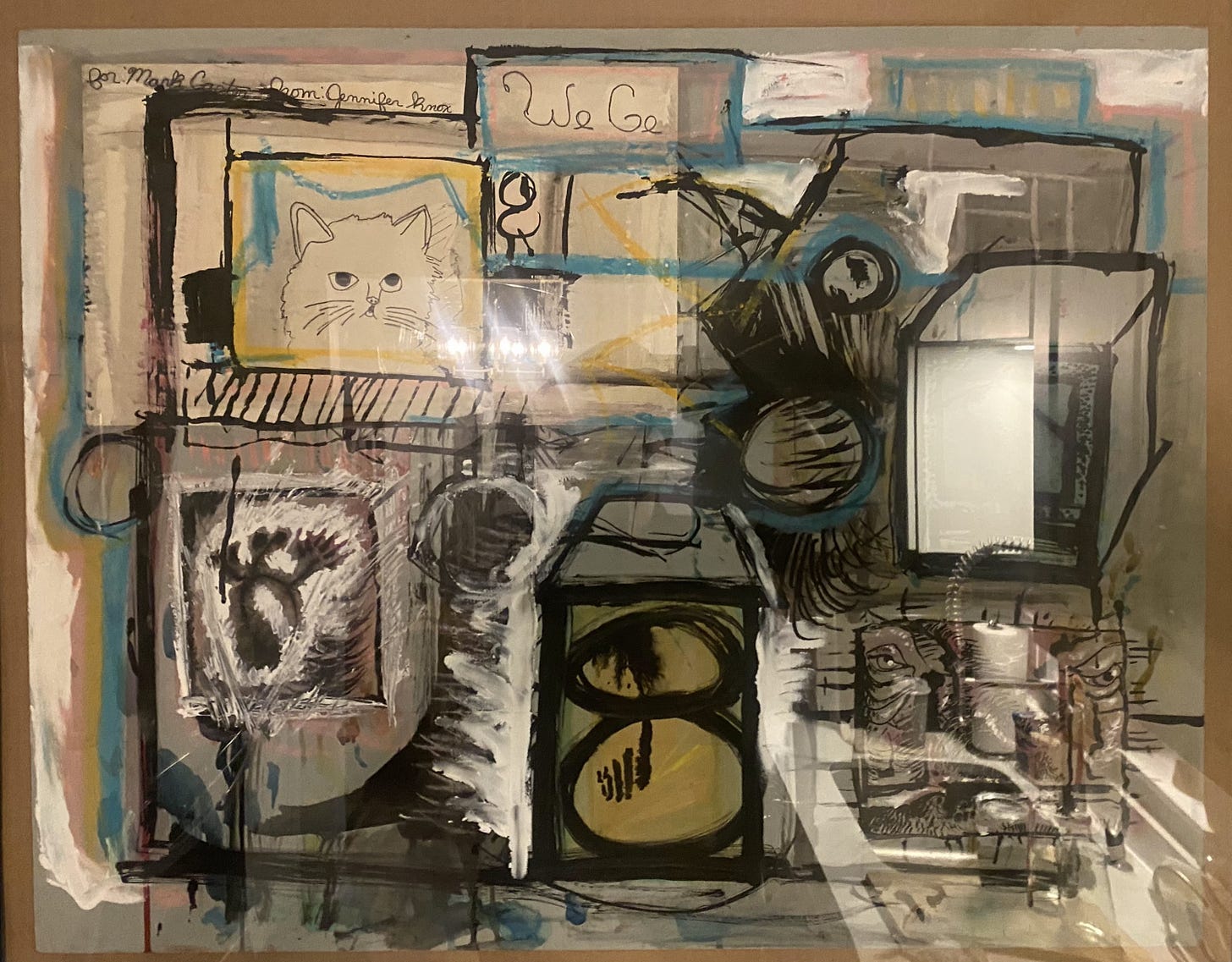On the church of art and story & week 46 of 52
a homage to artists
As a young kid, I drew my cat, Ouija (which I grossly misspelled), and gave it to my father’s good friend, Mark Carter. He later used it in this collage piece, which he gifted to my father. If you look at the upper left-hand corner, you can see my signature.
The fact that he kept this drawing of my perpetually annoyed cat speaks to the mind of a true artist.
Mark’s work can be found at the Thomas Dean Fine Art Gallery. He, like my father, is incredibly gifted and was a favorite of my parents’ friends because he was hilarious. He’d leave long voicemails in cartoon-like voices and make up telenovela-worthy stories about who he was and why he was leaving the message—all just to say, “Call me back.” I’d listen to them on repeat.
I grew up going to the church of Art & Story. My parents both read to me, and our bookshelves were full. We were not globe-trekking to museums with fancy art connoisseurs, but we had the stories and art at home. Our home smelled of old books and pencil dust. I loved holding my father’s large, bendable gray erasers to my nose and taking a deep inhale.
My sister and I helped my father collect old discarded mufflers and twisted tree branches for his sculptures. We found items on the side of the road, in the parks, and at a shuttered penitentiary where O. Henry wrote twisty fiction.
I saw artists revitalize the neighborhood I grew up in (before it was gentrified), and I read books that slowed my anxious mind enough to wrap me in a blanket of hope.
Nothing is more powerful than the distinct resilience of an artist or writers. Nothing.
And while I rebelled for a while, denying myself expression, art followed me. As I faced intense challenges (as we all do), I began to remember how powerful it can be to funnel pains and disappointments into words and stories, which appeared haphazardly, but mercifully, on the page.
Over time, they began to make sense. Over more time, they began to make some sense of the world.
“This is the power of art: The power to transcend our own self-interest, our solipsistic zoom-lens on life, and relate to the world and each other with more integrity, more curiosity, more wholeheartedness.” —Maria Popova
I am lucky. I saw how my father and other artists could take anguish and turn it into color and resonance and empathy through artistic expression. I saw my father’s untold stories released in stained glass and sculpture.
It feels as though we’re slipping into a Dark Age of suppression and conformity, driven by bullying, propaganda, and technology, but I believe it will be the artists and writers who save us.
We will save by combining efforts and remembering that, together, our narrative is stronger than any suppression.
AYTL Experiment #46: Collect any pain you feel. Use it. Funnel it all, all of it, into art this week.
Find a piece of art that is not in a museum or gallery. Find that drawing that someone left on a napkin in a diner or the graffiti near a creek. Find a child’s old drawing or a piece of a poem left unfinished, and write a homage to it. Or, repurpose it into the larger story of us, those who desire to connect with our words and expressions, to include and expand the meaning of what it is to be human.
Posted early to invite you to something … If you’re free, I’d love for you to join me on Saturday, March 29, for a moving meditation & intention-setting practice on Insight Timer.






If an artist sets OUT to "save the world," it seems a false journey. I don't think any artist of any stature should think of themselves as a role model. But if the work they do changes one mind, helps one troubled soul, relieves a fear, or shines a light, then yes, change the world. But it has to come organically. I never think of myself as being some kind of "savior" or some kind of moral compass. I don't have the weight or the bandwidth to even believe that. But "the work," as Patti Smith says, "continues."